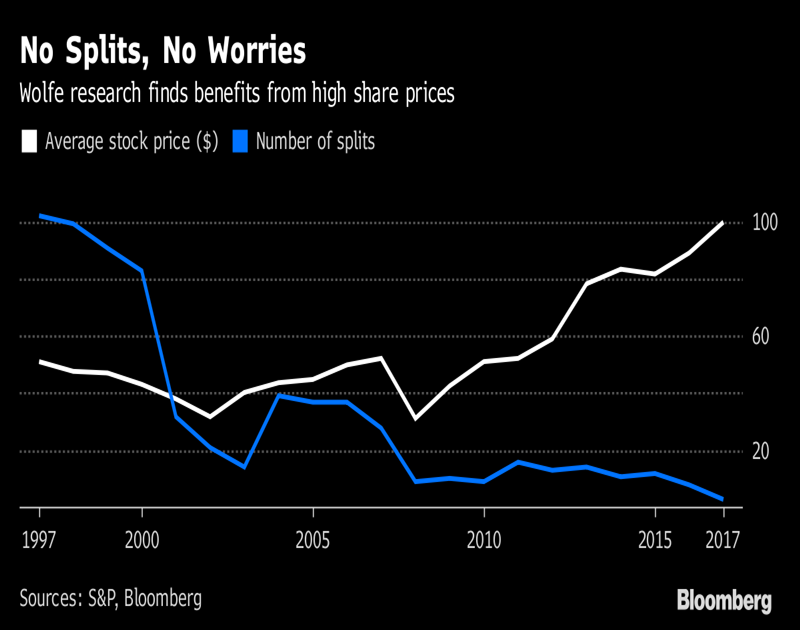One minor mystery of the bull market has been the almost complete disappearance of stock splits. New research suggest there’s more to it than just passive investors who don’t care what a share costs. A plethora of benefits accrue when equities trade in the three and four digits, says Wolfe Research. High-priced stocks have lower volatility, less short interest and lower transaction costs, the New York-based firm found. Stock splits have gone the way of landline phones since the internet bubble, when they were practically a coronation event for hot tech firms. Only four companies in the S&P 500 Index have had one this year, compared with 102 in 1997, data compiled by S&P Dow Jones Indices show.

Add a nine-year rally, and the result is way more companies trading above $100 — almost a third of S&P 500 members, as of Tuesday’s close. On average, shares cost $99.95, the most on record. “Companies may get a sense of pride and attention with elevated share prices, but this is difficult to objectify,” Wolfe strategists including Javed Jussa and Yin Luo wrote in a note Tuesday. “More importantly, we find that companies with higher share prices have three beneficial characteristics when analyzed through a quantitative lens.”
Volatility generally falls as shares rise, they found. Among seven groups ranked by price, stocks under $1 show the biggest price swings, with median realized volatility reaching 90 percent. As price goes up, fluctuations narrow to about 20 percent for stocks trading between $500 and $1000. High-priced stocks also deter short sellers, especially when it comes to small-cap companies. Short interest, as defined as active utilization by Wolfe, is 28 percent for the cheapest of the five groups. It keeps falling as share prices go higher and reaches 6 percent for the top ranks.




“Low levels of volatility will make these stocks less attractive to high-frequency traders, day traders, retail investors, and short-duration systematic strategies and in turn potentially more desirable to longer term investors,” the strategists wrote. As volatility goes lower, so does the market impact of buying and selling large lots, a determinant of transaction costs. For investors paying brokers on a per-share basis, a $1 million trade would also mean 10 percent savings on a $100 stock than a $10 stock.
Not everyone is thrilled with the extinction of splits. U.S. exchanges occasionally bemoan the trend, saying higher price tags deter individual investors. Chris Concannon, the president of CBOE Holdings, said in a May 2016 note that elevated prices can harm liquidity and investor participation, affecting returns and the value of equities. While the Wolfe study focuses on individual stocks, it comes at a time of near record tranquility in the market, with the VIX last month touching some of its lowest readings in two decades.
Could the prevalence of high-priced stocks be holding marketwide volatility down? That’s a stretch, say the authors. “There are many potential reasons behind the record low level of volatility,” Luo said in an interview. “Lack of splits and low market vol go side-by-side, but it’s probably too much to suggest lack of splits ‘cause’ low vol.”




















